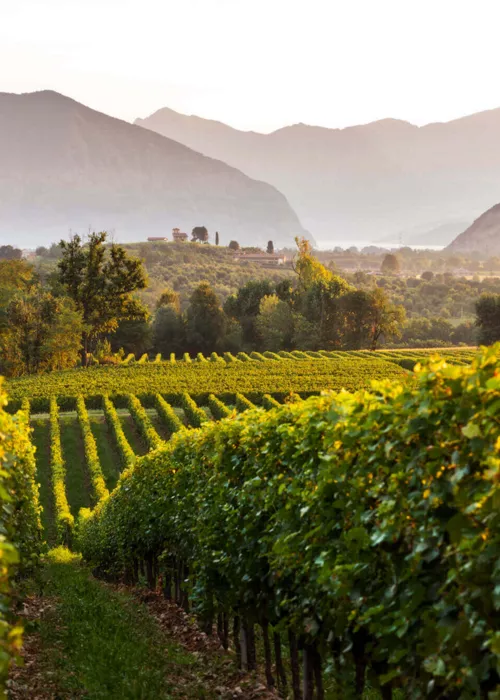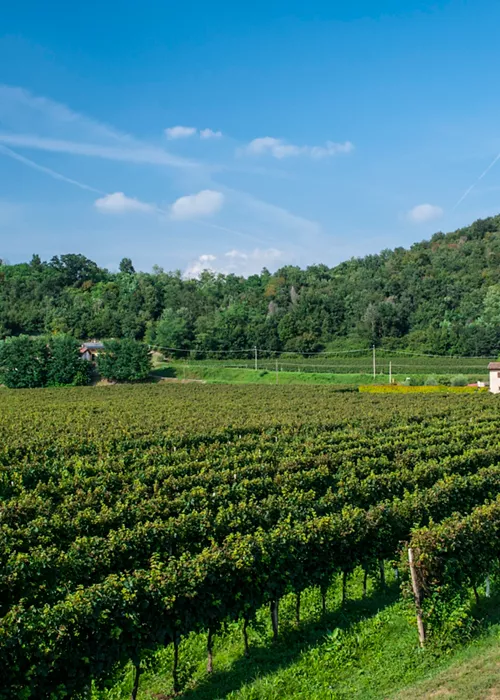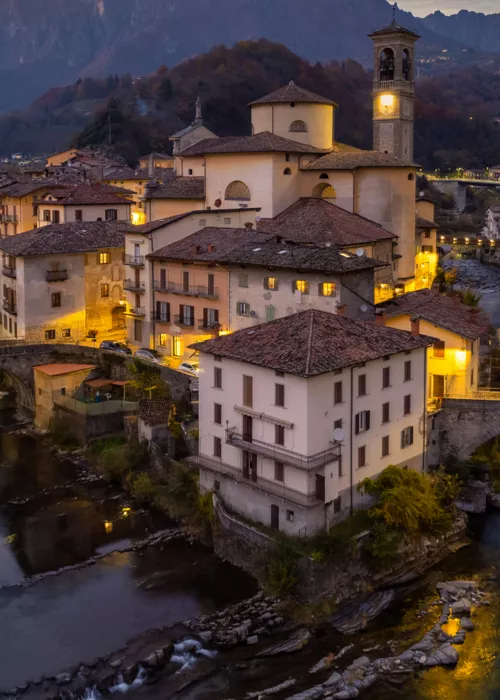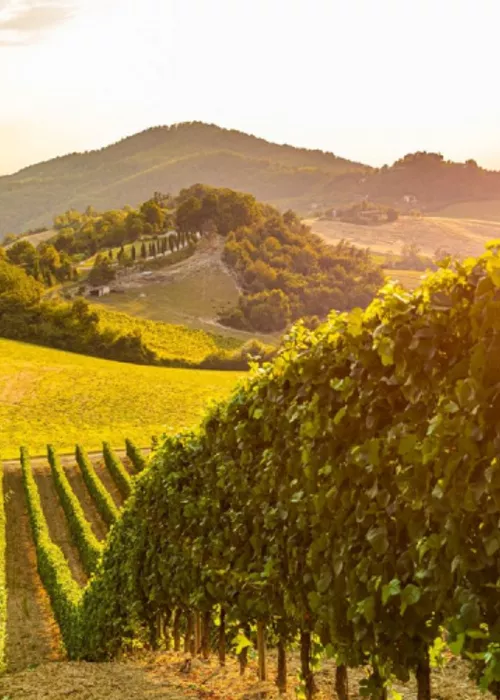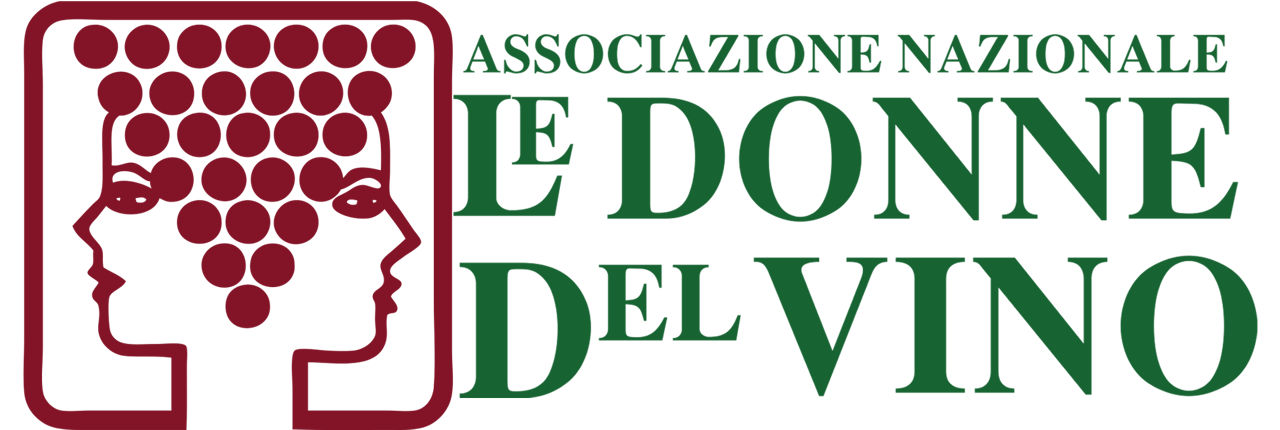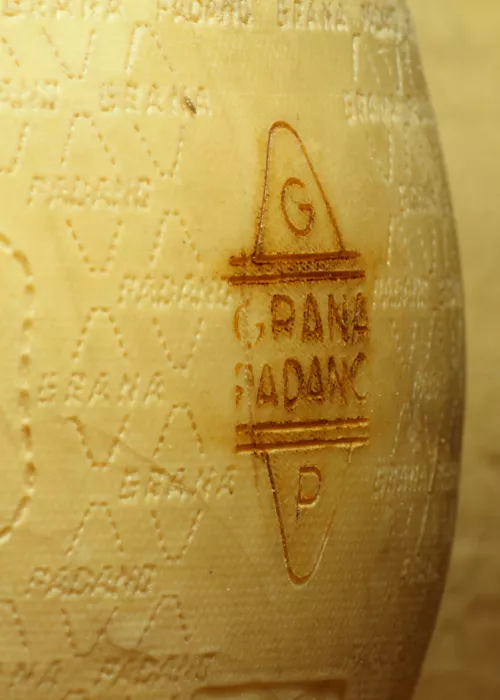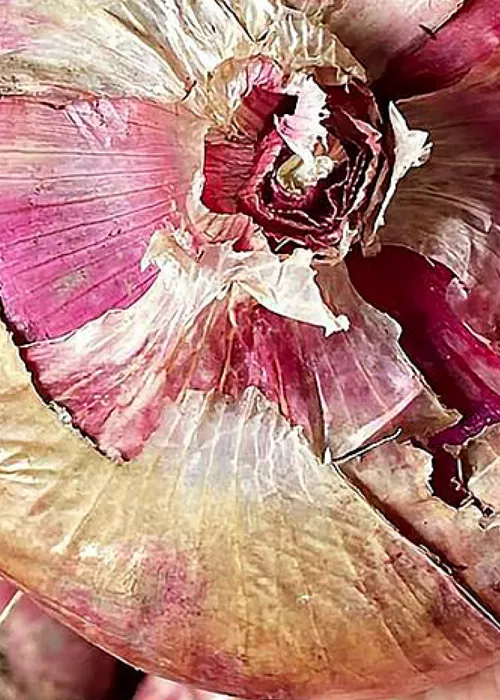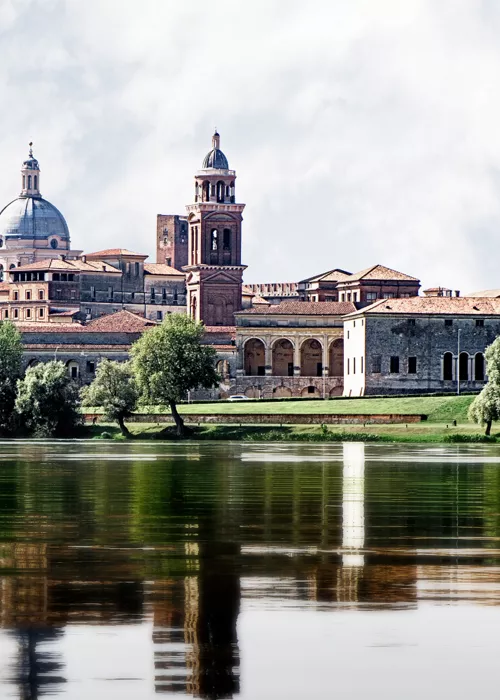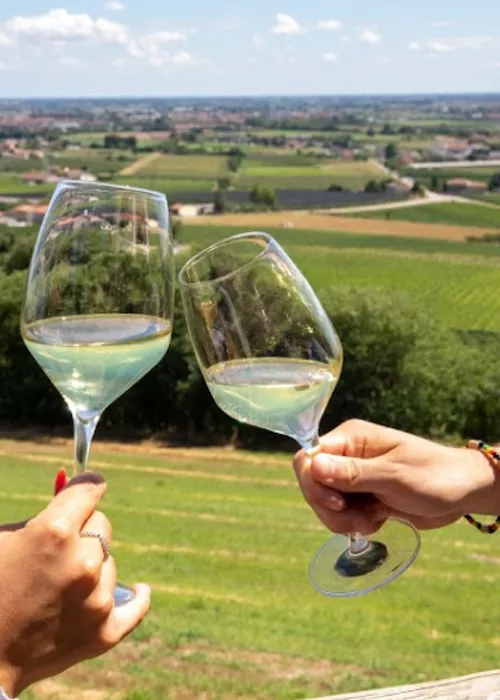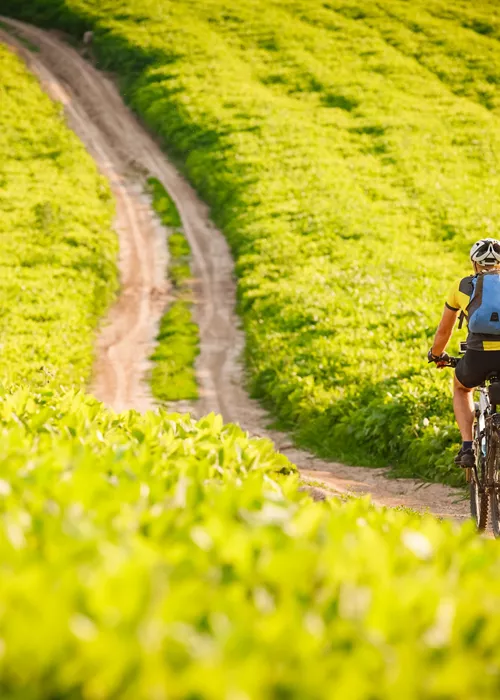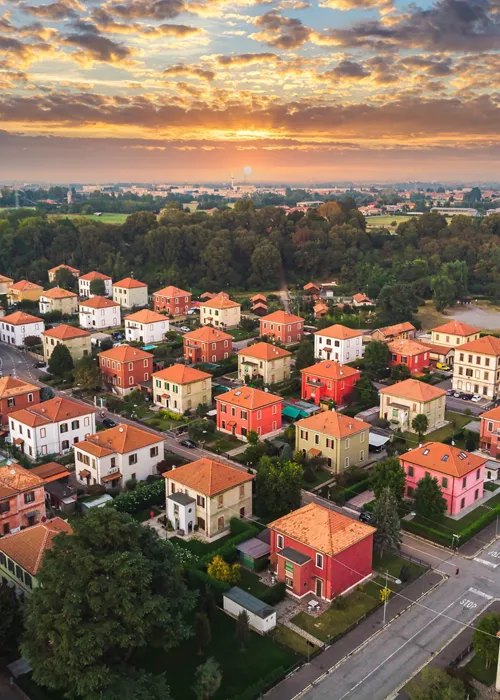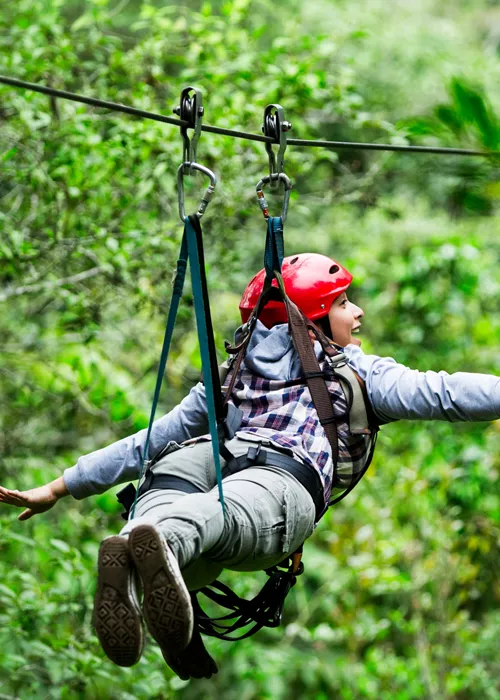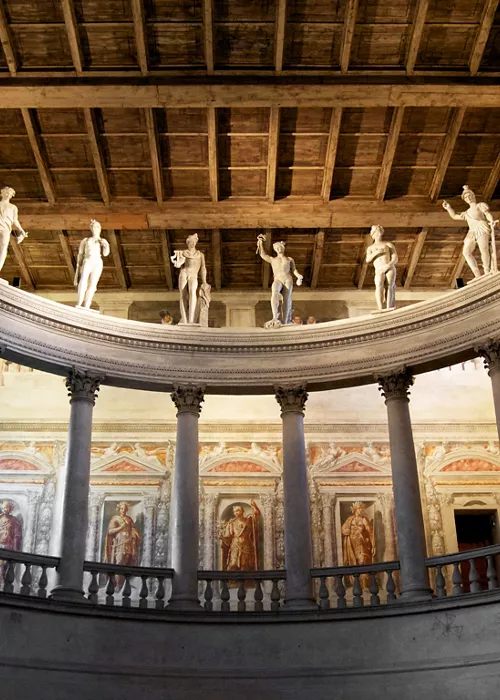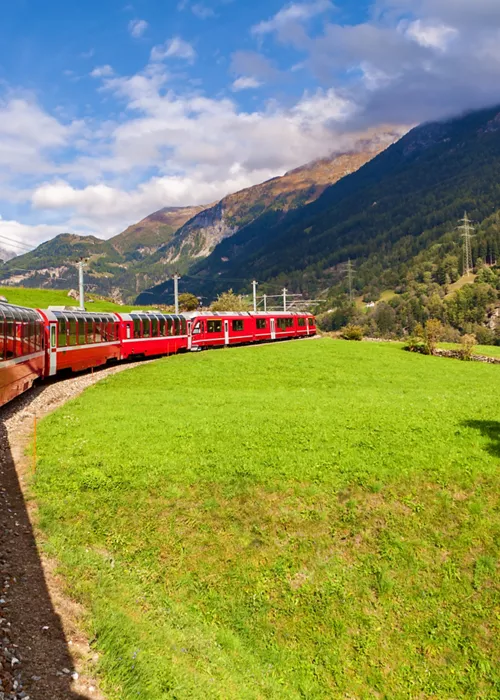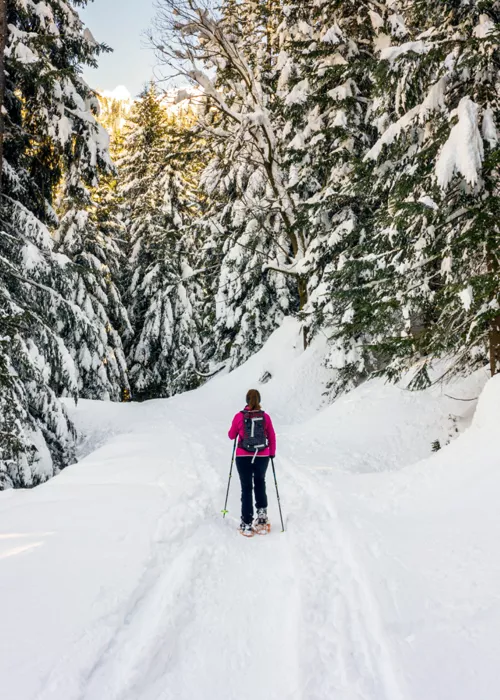Discovering Northern Lombardy - Bellano, Chiavenna and Almenno san Bartolomeo
16 minutes

You’d be hard pressed to find anything more picture-perfect than an Italian village overlooking a lake, unless of course it’s an Italian village in a dramatic mountain setting with waterfalls and a river running through.
It’s a tough call to make but I’m bringing you both so you won’t have to choose. Plus there’s a third Borgo packed with unique historical churches, museums and beautiful scenery. The good news is that they’re all within striking distance of each other.
Welcome to northern Lombardy and the medieval villages of Bellano, Chiavenna and Almenno san Bartolomeo. Let’s explore.
Bellano
Don’t miss:
- Dramatic gorge L’Orrido di Bellano
- A visit to Lezzeno for lunch
- The scenic Sentiero del Viandante
- Lakeside strolls
- The medieval old town and churches
Bellano is a charming town on the Eastern shore of Lake Como in the province of Lecco. Pastel painted buildings reflect across the calm waters of the lake and tree covered hillsides creep down to the water’s edge. Sailing boats sit alongside traditional Lucia boats in the tiny walled harbour and a warren of lanes lead from lakeside to the hillside that’s split in two by an ancient gorge.
Bellano is officially one of the most beautiful villages in Italy (Borghi più belli d’Italia) and I can see why. The village has also been awarded the Orange Flag (Bandiera Arancione) by the Touring Club Italiano in recognition of its excellence and quality in tourism.

L’Orrido
Bellano is most famous for its dramatic ravine, L’Orrido. The gorge was created around 15-million years ago as the waters of the Pioverna River and the Adda glacier coursed its way down to Lake Como.
At the start of the gorge is Cà del Diavol, a pentagonal tower adorned with a fresco of the devil. Inside are more frescoes and a multi-media exhibition about the history, geology and legend of the area.
As we walked through l’Orrido we saw how erosion has smoothed and shaped the rock to form dramatic canyons, potholes and gullies. We explored the gorge by traversing over a series of sturdy suspension bridges and walkways.
The powerful rush of water thundered below us forcing its way through crevices, over steep drops and into deep emerald green pools. The roar of the torrent and it’s power was incredible.
Ferns and flora grow freely from the canyon walls creating a tropical feel and a waterfall flows into a small pool. Towards the end we enjoyed a pretty area with colourful planting and benches, a tranquil place to just sit and soak up the amazing scenery.
At the top of the gorge we looked back down for wonderful views over the rooftops to the lake and from here we accessed the famous "Sentiero del Viandante".
To find the entrance of the gorge head to Church of Santi Nazzaro e Celso and take the steps on the right hand side.
Address:
Piazza S. Giorgio, 23822 Bellano
Hours: Open daily from 11am-1pm and 3pm-7pm. Entrance is adults €5, 6-12 years €3, under 6 years no charge.
Sentiero del Viandante
The central part of this ancient mule track which runs for 68 km (42.2 miles) is accessible from the top of the gorge. The trail dates back to Roman times and connects many hamlets and villages along the valley and the views are spectacular.
The trail has six stages which were all connected in 1992 and signage added. Spend a few days hiking the whole path or just one or two stages. We hiked a small stretch, enjoyed spectacular views of the lake and mountains and wished we’d had time for more.
Lunch in Lezzeno
We paid a visit to beautiful and peaceful Lezzeno, a small hamlet across the lake just beyond busy Bellagio. After exploring the tiny medieval alleyways, the Baroque Sanctuary and relaxing on the small beach I recommend a lakeside lunch at Ristorante Aurora Lezzeno.
The food, the panoramic lake views and the service are all excellent. We enjoyed a simple but authentic lunch of Penne all’arrabbiata followed by a selection of local cheeses and wine, of course!
The ferry terminal means you can visit many of Como’s lakeside towns and villages from Bellano, although we found a much reduced service in early October.
Lakeside Strolls and beaches
Bellano’s idyllic lungolago is a beautiful place to stroll. We walked to the headland just south of the ferry station where the views stretch right up to the snow-capped mountains at the top of the lake. It was a beautiful sunny day so a gelato was enjoyed as well as the scenery.
There are some pebbled beaches along the promenade for those that wish to enjoy a swim in the refreshing lake waters. A public beach is just beyond the outlet from the gorge and Lido di Bellano is nearby.
Bellano’s Centro Storico
Set back from the lake, narrow alleyways had us meandering through ancient archways, past medieval houses and into baroque piazzas.
We happened across the church of San Nazzaro and Celso in Piazza san Giorgio. The black and white marble façade of this Romanesque church is quite striking and it’s worth taking a peek inside at the frescoes, rose window and collection of art from the 14th to 16th centuries.
Right opposite you’ll find the Church of San Marta where you can admire the wooden ‘gruppo della pietà by Giovanni Angelo Del Maino, depicting the deposition.
Local Flavours
Risotto made with perch is a popular dish in Bellano. We saw large fish swimming in the lake so it’s a dish with ingredients as local as you could possibly get.
Useful information:
Best time to visit: Bellano will be busier in the summer months, therefore, shoulder season - Spring or Autumn would be a good option. We found the ferries weren’t so frequent during our visit in early October so you may wish to bear that in mind.
How to get there: The closest major city is Milan at 81.3 km (50.5 miles).
By car: If you’re driving this will take around 1.5 hours (with tolls). There’s plenty of paid parking once you reach Bellano.
By Train: Bellano has a train station, Bellano Tartavalle Terme, which serves regional trains on the Lecco-Colico-Sondrio route as well as the RegioExpress trains operating between Milan-Lecco-Sondrio-Tirano.
By Ferry: Bellano also has a ferry terminal which is convenient if you’re staying in a nearby town. Check the Navigazione Laghi website for boat times.
By Bus: There is a regular bus service to and from Bellano from the surrounding towns and major cities.
Chiavenna
Don’t miss:
- Admire the exquisite Palazzo Vertemate Franchi in the hills
- Visit the beautiful Aquafraggia waterfalls
- Have lunch in one of the Crotto restaurants
- Explore the town
- Sample the produce at Chiavenna’s Bresaola Festival
Chiavenna sits north of Lake Como at the foot of the Maloja Pass. The town is enveloped by a horseshoe of dramatic mountain scenery and surrounded by dazzling panoramas in every direction.
Chiavenna has been awarded the Orange Flag (Bandiera Arancione) by the Touring Club Italiano. The prestigious award is a recognition of quality awarded to small towns (population 15,000 or less) in Italy for excellency in tourism, hospitality and the environment.
In the historical centre, medieval lanes lead to pretty piazzas and the Mera river, crossed by old stone bridges, dances its way through the valley. There are towering waterfalls, caves, churches and all the flavours of the mountains – cheeses, salted meats and buttery pasta dishes. Welcome to Chiavenna in the province of Sondrio.

Palazzo Vertemate Franchi
Chiavenna is located on the road that connected Milan to Engadina and Munich. Merchants would pass through the valley on their way to and from the north to trade. Piuro, a town just north of Chiavenna was a principal trading centre between Italy and the rest of Europe.
The Vertemate Franchis, the wealthiest merchant family in the area by far, built the villa as their summer palace and we visited on a glorious day of crisp blue skies, sunshine and fresh mountain air.
Palazzo Vertemate Franchi is a simple looking structure from the outside but inside this Renaissance masterpiece is impressive. We were transported into a world of beautifully preserved frescoes, intricate inlaid wooden ceilings and atmospheric paintings.
Our fabulous guide, Aurora, brought the Palazzo alive with stories, fascinating snippets of family history and life in the villa. The beautifully preserved frescoes depict the Ovid’s metamorphosis, astrological signs and mythological scenes.
Above the Bishop’s Room there’s a trap door concealed in the superbly carved wooden ceiling. It’s said that this was an escape route, although the Bishop was fond of young maids who seemingly arrived in his bedroom each night through said trap door. Think what you will.
In the grounds you’ll find the tiniest of chapels, chestnut groves, a sunken garden and the walled vineyard – the only one of its kind in Lombardy. From the terrace we stood and immersed ourselves in the remarkable views. The villa was my favourite place in Chiavenna, I could have stayed forever.
Aquafraggia Waterfalls
This spectacular double waterfall is the centrepiece of the nature reserve with a huge variety of hiking trails starting at the base of the falls. I’d have loved to have the time to hike some of them.
The surrounding park is a beautiful spot to spend time in nature, take a picnic or just admire the falls which drop 150m into the River Mera. Hike or bike to the falls which are located just 2 km outside Chiavenna.
The Crotti
Chiavenna sits within a valley surrounded by mountains. Ancient landfalls of boulders have formed small caves and vents in the rocks. These ‘crotti’ have a constant breeze circulating, called the Sorél, which maintains a steady temperature of 4-8 degrees all year round. Perfect for preserving cheese, cured meats, bresaola, and of course wine. The crotti have been used for centuries for this very purpose.
It makes perfect sense for restaurants to be located by these natural refrigerators and in Chiavenna there’s a whole run of crotti restaurants. We sat on the sunny terrace at Crotto Ubiali and feasted on a meal of cold cuts, deep-fried Bitto cheese, polenta zola, succulent ribs and Gnocchetti di Chiavenna – my absolute favourite meal of our visit to Lombardy.
Explore the historical centre
There’s a lot to see just by wandering the ancient lanes and palazzos of Chiavenna. Walk through the cloistered grounds and bell tower of San Lorenzo Monastery, home of the Museo del Tesoro and a number of significant artefacts. Don’t miss the huge Ollare stone, or pot stone, font that dates back to 1156.
A charming old stone bridge crosses the Mera River with a stunning backdrop of mountain scenery. The best views are from a second bridge down river but take time to cross the stone Mera bridge to see the statues guarding over it.
The Botanical Gardens
After our wander through the historical centre we headed to the Paradise Botanical Archaeological Park. It’s located high up in a wonderful position with outstanding views over the town and valley.
The gardens comprise of two hills: the Paradiso and the Castellaccio which are divided by a small gorge and connected by a footbridge and pathways. It’s a bit of a climb but worth the effort for the 360 degree views from the ruined fortress and it will help work off some of that Gnocchetti di Chiavenna.
Local Flavours
For a taste of Chiavenna’s gastronomic heritage you must try the bresaola. This typical salted beef is produced from a lean, tender cut, rubbed with a mix of spices and then aged for 2-3 months until it becomes hard and turns a deep red colour.
We were in Chiavenna on the day of “Dì della Bresaola” – the Bresaola Festival. A wonderful time was spent sampling paper thin slices of bresaola in a dozen stalls situated around the village. Each one had their own particular flavour and we really couldn’t choose a favourite. I just wish I’d brought some home with me. The atmosphere was lively, fun and full of local colour.
Useful Information:
Best time to visit: I can’t imagine Chiavenna being anything but beautiful at any time of year nor too busy. Go for the Sagra (crotti) festival in September or the Bresaola festival in October if you’re a foodie. For hiking and outdoor activities, aim for Spring before the weather gets too warm.
How to get there: The nearest major city is Milan at 124 km (75 miles)
By Car: From Milan it’s a scenic 2-hour drive following the eastern shore of Lake Como.
By Train: The train journey takes about 2.5 hours from Milan and you’ll need to change trains at Colico. Only regional trains reach Chiavenna so bookings are not needed.
Almenno san Bartolomeo
Don’t miss:
- Visit Rotonda di San Tomè church
- Enter the world of wood at Tino Sana Woodworking museum
- Hike or bike in the Romanesque Park
- Have coffee at historic Caffetteria La Pasqualina
- Visit Clanezzo Bridge and Port
Almenno san Bartolomeo is a small village located at the mouth of the Imagna Valley in the province of Bergamo. The area, which sits within the Romanesque Park, was once called the ‘Lemine’ and is made up of plains, meadows and woodland which make it perfect hiking and biking territory. As well as being surrounded by nature the village has some cultural highlights which make the area well worth visiting.
Almenno san Bartolomeo has been awarded the Orange Flag (Bandiera Arancione) by Bandiere Arancioni Touring Club Italiano in recognition of its excellence and quality in tourism.

Rotonda di San Tomè
Our first stop in Almenno san Bartolomeo is a charming and unusual Romanesque church. Rotonda di San Tomè is an extremely rare round church which blends perfectly with its surrounding landscape. Built between 1130 and 1150 San Tomè is one of only eight rotunda churches in the world.
As we stepped inside, a soft light and hushed air of tranquillity enveloped us. I couldn’t resist the urge to stand in the centre and turn full circle to fully take in my surroundings.
The church is made up of three cylinders with a rectangular presbytery and semi-circular apse. There’s a women’s gallery on the upper level supported by a circle of columns and faint traces of frescoes remain on the walls.
From the top gallery, which is closed for safety reasons, there are two open circular windows and two in the shape of a cross. We found this part of the church absolutely fascinating because these open windows are linked to solar cycles and lunar phases.
On equinox days, the weather being right, a beam of sunlight enters through the round opening and illuminates the altar. On solstice days and during some lunar phases, light projects the image of a cross on the wall opposite.
There are four other beautiful churches in the vicinity with a range of frescoes and notable features which we didn’t have time for. Details can be found on the Lemine Foundation website.
The Romanesque Park
Rotonda di San Tomè is a good point to start a walk or bike ride through the Romanesque Park. There’s a small café on site and an information centre where they’re very friendly and will help you plan your visit to Almenno san Bartolomeo.
Tino Sana Woodworking Museum
I loved the story behind Tino Sana woodworking museum almost as much as the museum itself. It’s very much a family affair and we were lucky enough to be shown around the museum by Sano’s daughter Aurora.
Carpenter, Tino Sana, was dedicated to his profession, during which he collected the tools of his trade. He accumulated tools that were no longer in use, replaced by modern machinery and wooden pieces from times past crafted by these tools.
Sana’s business was successful, supplying bespoke wooden furniture to hotels, cruise lines and designer shops. He also had an ever-growing collection which he displayed in the reception of his workshop.
As the business grew, so did the collection, which is now housed on three floors of the spacious and modern Tino Sana Woodworking Museum. We saw every kind of wooden creation during our visit from musical instruments, a WW1 aeroplane and furniture to looms, puppets and even a modern wooden bicycle. The museum is an amazing insight into the world of wood.
As well as preserving the history of carpentry there’s a school of woodworking on site where students are trained in professional carpentry and the crafting of wood. Tino Sana is no longer with us but his work and his passion for wood live on and continue to evolve.
I highly recommend a visit to the museum but do check opening times on the Tino Sana website as they are not open all day.
Address: via Papa Giovanni XXIII, 59, Almenno San Bartolomeo
La Pasqualina
This little lovely little coffee shop and pastry bar in Almenno san Bartolomeo has been serving fabulous coffee, hot chocolate and pastries since 1912. The bar was founded by Piero Daina and Pasqualina Locatelli as an inn for hunters.
Nowadays it’s run by their great-grandson Richard Schiavi who does a fabulous line of gelato. La Pasqualina has ranked in the top positions of the Gambero Rosso Bar Guide of Italy since 2018. It’s the perfect stop for a coffee and cake during your visit to the village.
I can highly recommend the panettone with your morning cappuccino.
Clanezzo’s Bridges
Just 10 km (6.2 miles) from Almenno san Bartolomeo on the Brembo river is a pretty spot which you should take time to visit if you’re nearby. The village of Clanezzo is home to two very different bridges. One very old and one very new.
We’ll start with the old bridge. This very pretty, stone bridge was built by Attone Guiberto, Count of Lecco, in 975 and is named the Attone Bridge. It crosses the Imagna stream and by building this bridge the Imagna Valley, Clanezzo in the Brembana Valley and the Almenno Plain were all connected making life very much easier for the Count.
Just a few minute’s walk away, past the old Customs House, is another completely different bridge. The Passerella, also known as the ‘dancing bridge’ is a suspended 75 metre (246 ft) Tibetan Bridge which has recently been refurbished. Before the bridge was built at the end of the 19th century the only way to cross the river was by boat.
The views of the emerald green Brembo river from the suspension bridge are well worth the wobbly walk. We could feel the bridge ‘dancing’ beneath our feet as we crossed. I can imagine that in summer time riverside picnics and walks in this gorgeous scenery would be idyllic.
Local Flavours
Quarenghi cake is a delicious cake invented to celebrate architect Giacomo Quarenghi who was born in Rota d'Imagna. The doughnut-shaped cake is made from cornflour and filled with chocolate chips, pears and dried figs. There’s also a special ingredient, a slurp of vodka, probably due to the fact that he spent most of his life in St Petersburg, Russia.
Best time to visit: Almenno san Bartolomeo is pretty much under the radar meaning that any time is a good time to visit because it never gets too crowded.
How to get there: The closest major city is Bergamo at 13 km (8.1 miles) away which is less than 15 minutes by car. There is a limited bus service from Bergamo which takes 46 minutes although there are only 3 buses per day.
As you can see, the villages of Bellano, Chiavenna and Almenno san Bartolomeo all offer a huge range of things to see and do which appeal to all kinds of tastes and interests. From history, culture and stunning scenery to outdoor adventure, charming villages, food, wine and culture. We loved exploring northern Lombardy and highly recommend adding a few days here to your next visit to Italy.
Article written about the experience of Suzanne Jones - The Travelbunny.


